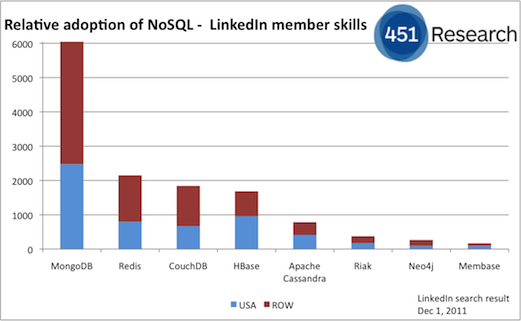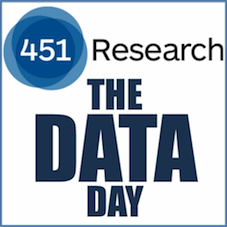February 22nd, 2013 — Data management
Aster Discovery. Delphix and SAP. Hadoop use-cases. And more.
And that’s the data day, today.
February 8th, 2013 — Data management
Teradata results. Funding for DataXu. The chemistry of data. And more.
And that’s the data day, today.
February 8th, 2013 — Data management
One of the most complicated aspects of putting together our database landscape map was dealing with the growing number of (particularly NoSQL) databases that refuse to be pigeon-holed in any of the primary databases categories.
I have begun to refer to these as “multi-model databases” in recognition of the fact that they are able to take on the characteristics of multiple databases. In truth though there are probably two different groups of products that could be considered “multi-model”:
True multi-model databases that have been designed specifically to serve multiple data models and use-cases
Examples include:
FoundationDB, which is being designed to support ACID and NoSQL, but more to the point in this instance, multiple layers including key-value, document, and object layers
Aerospike, which is planning to combine SQL, key value, and document and graph database technologies in a single database by bringing together its Citrusleaf NoSQL database with the acquired AlchemyDB NewSQL project
OrientDB, which is, at heart, a document database, but can also be used as a graph database; as an object database, making use of the Java persistence API; and as a hybrid database, taking advantage of multiple models to serve different application requirements
ArangoDB, which promises to deliver the benefits of key value and document and graph stores in a single database
Other products that could be considered true multi-model databases are:
Couchbase Server 2.0, which can be used as both a document store and a key value store, as well as a distributed cache
Riak, which is a key-value store, although it can be used as a document store since the value can be a JSON document
NuoDB, which will provide compatibility with other databases by taking on multiple ‘personalities’ – an Oracle personality via PL/SQL compatibility is in the development roadmap, as is a document store personality via JSON support.
General-purpose databases with multi-model options
What’s the difference between multi-model databases and existing general-purpose databases that have optional capabilities for serving multiple models? My book book it’s about being designed for purpose, but I’m sure that will be a debating point for the future. In the mean-time, examples include:
Oracle MySQL 5.6, which can support both SQL-based access and key-value access via the Memcached API.
Oracle MySQL Cluster 7.2, which similarly supports concurrent NoSQL and SQL access to the database.
IBM DB2 10, which extends DB2’s hybrid relational and XML engine to enable the storage and management of graph triples, as well as support for the SPARQL 1.0 query language.
Akiban Server, which has the ability to treat groups of tables as objects and access them as JSON documents via SQL.
PostgreSQL h-store, which can be used for storing key-value pairs within a PostgreSQL data field, thereby enabling schema-less queries against data stored in PostgreSQL
We are also aware of other NewSQL database that plan to adopt support for popular NoSQL data models, while IBM has also talked about plans to integrate key value store NoSQL access capabilities with DB2 and Informix database software.
Other products that could be considered multi-model options include:
Oracle Spatial and Graph, an option for Oracle Database 11g.
One of the drivers of NoSQL database adoption has been polyglot persistence – using multiple databases depending on the specific requirements of individual applications. Multi-model databases contradict this trend, to some extent, so it will be interesting to see whether they begin to gain traction.
While we see the wisdom of selecting the best database for the job, we also recognise that it could sometimes be a matter of choosing the best data model for the job, while relying on a single storage back-end.
January 10th, 2013 — Data management
451 Research’s 2013 Database survey is now live at http://bit.ly/451db13 investigating the current use of database technologies, including MySQL, NoSQL and NewSQL, as well as traditional relation and non-relational databases.

The aim of this survey is to identify trends in database usage, as well as changing attitudes to MySQL following its acquisition by Oracle, and the competitive dynamic between MySQL and other databases, including NoSQL and NewSQL technologies.
There are just 15 questions to answer, spread over five pages, and the entire survey should take less than ten minutes to complete.
All individual responses are of course confidential. The results will be published as part of a major research report due during Q2.
The full report will be available to 451 Research clients, while the results of the survey will also be made freely available via a
presentation at the Percona Live MySQL Conference and Expo in April.
Last year’s results have been viewed nearly 55,000 times on SlideShare so we are hoping for a good response to this year’s survey.
One of the most interesting aspects of a 2012 survey results was the extent to which MySQL users were testing and adopting PostgreSQL. Will that trend continue or accelerate in 2013? And what of the adoption of cloud-based database services such as Amazon RDS and Google Cloud SQL?
Are the new breed of NewSQL vendors having any impact on the relational database incumbents such as Oracle, Microsoft and IBM? And how is SAP HANA adoption driving interest in other in-memory databases such as VoltDB and MemSQL?
We will also be interested to see how well NoSQL databases fair in this year’s survey results. Last year MongoDB was the most popular, followed by Apache Cassandra/DataStax and Redis. Are these now making a bigger impact on the wider market, and what of Basho’s Riak, CouchDB, Neo4j, Couchbase et al?
Additionally, we have been tracking attitudes to Oracle’s ownership of MySQL since the deal to acquire Sun was announced. Have MySQL users’ attitudes towards Oracle improved or declined in the last 12 months, and what impact will the formation of the MariaDB Foundation have on MariaDB adoption?
We’re looking forward to analyzing the results and providing answers to these and other questions. Please help us to get the most representative result set by taking part in the survey at http://bit.ly/451db13
December 3rd, 2012 — Data management
451 perspectives on RedShift and Precog. And more
And that’s the Data Day, today.
April 19th, 2012 — Data management
March 27th, 2012 — Data management
Back in December we ran a series of posts looking at the geographic distribution of NoSQL skills, according to the results of searching LinkedIn member profiles, culminating in a look at the relative overall popularity of the major NoSQL databases.
This week I took another look at LinkedIn to update the results for a forthcoming report, which gives us the opportunity to see how the results have changed over the past quarter:

While this provides us with an interesting opportunity to track LinkedIn profile mentions over time there isn’t a huge amount we can learn from this first update – other than that MongoDB seems to be increasing its dominance.
The only significant change that isn’t immediately obvious from looking at the chart is that Apache HBase has overtaken Apache CouchDB by a tiny margin to claim third place overall.
As we noted last time, however, Apache HBase is more reliant on the US than other NosQL databases for its LinkedIn mentions: it is the second most prevalent NoSQL database mentioned in the USA but fourth in the rest of the world.
Two other points to take into consideration:
– The results for Apache Cassandra are probably disproportionately low since we have to search for the full phrase in order to avoid including people called Cassandra.
– Previously we only searched for Membase. This time we added together the search results for both Membase and Couchbase. This may mean the result for Couch/Membase is disproportionately high since some members probably listed both.
This is not meant to be a comprehensive analysis, however, but rather a snapshot of one particular data source.
February 24th, 2012 — Data management
January 13th, 2012 — Data management
December 12th, 2011 — Data management
Hidden away amongst the details of our little tour around LinkedIn statistics on NoSQL and Hadoop skills was some interesting information on how many LinkedIn members list the various data management technologies in our sample in their profiles.
Our original post contained the fact that there were 9,079 LinkedIn members with “Hadoop” in their member profiles, for example, compared to 366,084 with “MySQL” in their member profiles.
Later posts showed there were 170 with “Membase” and 1,687 with “HBase”, 787 with “Apache Cassandra” and 376 with “Riak”, 6,048 with “MongoDB” and 2,152 with “Redis”, and finally, 1,844 with “CouchDB” and 268 with “Neo4j”.
This gives us an interesting perspective on the relative adoption of the various NoSQL databases:

If it wasn’t already obvious from the list above, the chart illustrates just how much more prevalent MongoDB skills are compared to the other NoSQL databases, followed by Redis, Apache CouchDB, Apache HBase and Apache Cassandra. The chart also illustrates that while HBase is the second most prevalent NoSQL skill set in the USA, it is only fourth overall given its lower prevalence in the rest of the world.
In response, a representative from a certain vendor notes “Some skills are more valued not because they are more prevalent, but because they are harder to achieve.” Make of that what you will.





 Subscribe via RSS
Subscribe via RSS